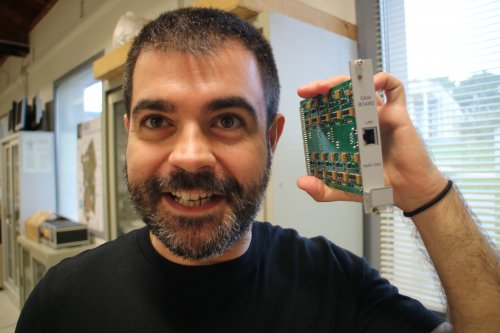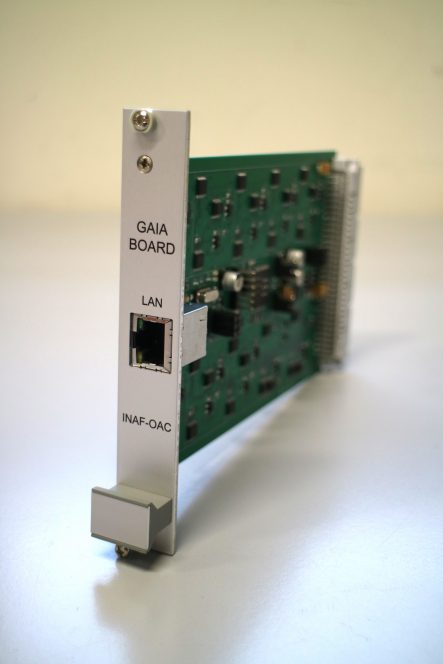
Radio telescopes are large dishes that receive and process very weak electromagnetic waves from various sources in the universe, such as stars and galaxies. In these complex technological systems, everything revolves around the “receiver,” its sensitivity, and the threats to its regular functioning, which are mainly radio frequency interferences (RFI). These interferences come from other emitting antennas—such as telephony, radio, television—but also from wind farms, cable ducts, electrical substations, malfunctioning appliances, alarms, electric gate motors, and so on. Moreover, electromagnetic interferences are also produced, especially, by the radio telescopes’ own reception systems, as they require electrical power to operate. For this reason, new solutions and ideas are continuously being studied.
One of the most advanced and pioneering solutions at the international level has now been found through a collaboration between the National Institute for Astrophysics (INAF), the Italian Space Agency (ASI), and the Department of Electrical and Electronic Engineering (DIEE) at the University of Cagliari. As reported in a study published in May of this year in the American journal IEEE Access, a team led by INAF Cagliari’s electronic engineer Pierluigi Ortu has developed an electronic board that promises to radically change the rules of the game in terms of receiver management, radio interference limitation, time optimization, and, not least, work safety during radio astronomical observations of the SRT, the Sardinia Radio Telescope (for now).
Between the conception, development, and fine-tuning of Gaia—the name of the board, which is not an acronym and has nothing to do with the ESA’s namesake space mission—seven years have passed, along with an incalculable amount of working hours by a team of nine people from the three involved institutions. Today, in 2023, Gaia has become a reality and is already being implemented on some of the new receivers available to the Sardinia Radio Telescope, built from scratch thanks to the recently concluded Pon-Innovation project. But how does this board work in practice? Let’s start with the cryogenic receivers and then move on to their power supply.
Cryogenic receivers
Cryogenic receivers (literally “cold producers”) require a lot of electrical energy to be maintained at the intended working temperatures—constant and extremely low, very close to absolute zero, achieved through progressive systems that we might call “cold matryoshkas” using helium gas. The cold serves to slow down the atoms of the receiving surfaces almost to a halt, thus ensuring the reception of an external signal in an environment as still and silent as possible.
In addition to merely receiving the signal, the receivers also have the task of amplifying it as much as possible with specific devices called Low Noise Amplifiers (LNA). After passing through this initial external reception interface—the front end—the signal can be digitized and processed in the subsequent environment—the back end—so that it can then be made available as usable data for radio astronomers. In practice, the receiver is the interface between the real signal coming from the sky and the amplified and digitized signal downstream of the system.
The power supply of the receivers and the concept of bias
Analogous to the mechanical concept of “torque”—which in an internal combustion engine represents the maximum efficiency between engine speed and power output—there is also an optimal operating range in the power supply of receivers, called “bias”: a point of balance between various types of current and voltage (gate voltage, drain voltage, and drain current) where the electrical flow reaches maximum efficiency and produces the minimum of unwanted electromagnetic emissions. To ensure that a receiver’s bias was constantly in optimal condition, INAF and ASI technologists and engineers had long ago developed a monitoring system capable of remotely sending—via a wired LAN network, from the receiver to a computer located in the control room area, outside the telescope—precise information on the receiver’s status and the quantity and quality of incoming electrical flow. However, there was no capacity for control and intervention.

The Gaia board promises to revolutionize the management of the Sardinia Radio Telescope receivers and, in perspective, also of other radio telescopes, both Italian and foreign, thanks to the ability to remotely control the optimal current flows for their operation. Credits: P. Soletta/INAF
Once an anomalous data or malfunction was detected, it was always necessary to physically intervene on the receiver mounted on the telescope to adjust this electrical flow, literally armed with a screwdriver to “give it a half turn” and restore the correct current flow. It’s not hard to imagine the practical implications: stopping and securing the telescope in a parking position, organizing a mission of technicians inside it (with related communications, scheduling, and bureaucracy), and the risks associated with working at height. These interventions required a lot of “antenna time” and inevitably affected the timing of already scheduled observations, causing them to overlap, delay, or cancel.
All this could soon be just a memory, if not for everyone, at least for a good part of the receivers currently active on the SRT, because the Gaia system provides—not only remote monitoring of receiver parameters, already available—but especially the ability to intervene on the electrical flows directly from a distance, optimizing them to the maximum and thus avoiding the physical mobilization of technicians and engineers to hunt for the fault. Of the approximately ten receivers currently built for the SRT, more than half are already ready to mount and use this new system, which represents a revolutionary and pioneering novelty from a certain point of view at the global level.
Pierluigi Ortu (INAF) does not hide his enthusiasm for this result. “These have been years of intense work, elbow to elbow with colleagues from ASI and DIEE to refine every detail of this board to the extreme, which today represents the ultimate in technology and efficiency in radio astronomical science, a true benchmark that is already making waves thanks to its publication in the leading American journal. To achieve such a productive work environment, the Sarda Sensors project, led by Tonino Pisanu and funded by the Sardinia Region to open our technological development to society and local businesses, was fundamental. From this context, the genesis of Gaia began. I would also like to emphasize that most of the people involved in the project started in a precarious condition. Although precarious, many human resources are essential to carry out important projects and should be valued and protected by their originating institutions with due attention.”